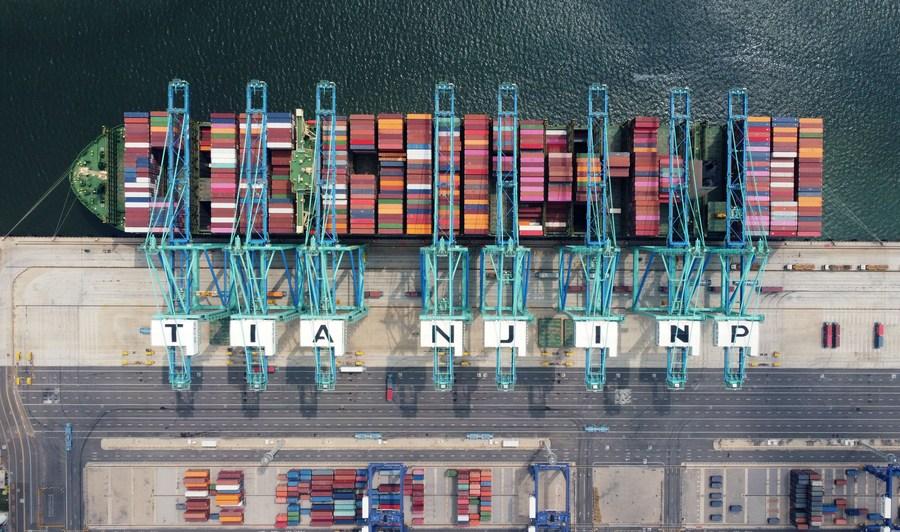chinadaily.com.cn | August 9, 2023

This aerial photo shows a cargo ship at a smart container terminal of Tianjin Port in north China's Tianjin, July 7, 2023. (Xinhua/Zhao Zishuo)
China's foreign trade grew steadily in the first seven months of the year but exports in July declined at a steeper-than-expected pace amid subdued global consumer demand, which highlights the need to roll out stronger policy steps to further boost the country's foreign trade, experts said on Tuesday.
High-tech and green products, the diversification of trading partners in emerging markets and more intensive government support should serve as key factors in sustaining the stable performance of exports, as part of the efforts to better support the country's sound economic recovery, they added.
Their comments came after data released by the General Administration of Customs on Tuesday showed that the country's foreign trade grew by 0.4 percent year-on-year to 23.55 trillion yuan ($3.27 trillion) in the first seven months.
Lyu Daliang, a spokesman for the GAC, said that the country's foreign trade has been running smoothly in general and is in line with expectations while the long-term good fundamentals have not changed.
It is worth noting that China's exports in July declined 9.2 percent from a year ago to 2.02 trillion yuan while imports shrank 6.9 percent year-on-year to 1.44 trillion yuan, the data showed.
Li Dawei, researcher at the Chinese Academy of Macroeconomic Research's Institute for International Economy, said the authorities should offer services such as exchange rate hedging, process export tax rebates faster, expand the scale of export credit insurance services and enhance customs clearance to help foreign trade firms reduce costs and overcome difficulties.
Meanwhile, it's of great importance to foster new drivers of export growth amid falling global demand for the country's traditional export products such as electronic items, clothing and footwear, Li said.
Tech-intensive green products such as solar batteries, lithium-ion batteries and electric vehicles will be given more prominence to shore up foreign trade growth further, Li said, adding that it will help the country to move up the global value chain and facilitate industrial upgrading at home.
According to statistics from the GAC, in the first seven months, automobile exports surged 118.5 percent year-on-year to 383.73 billion yuan, while the exports of cellphones and labor-intensive products fell 6.5 percent and 2.1 percent, respectively, year-on-year.
The year-on-year slump in China's exports for three consecutive months since May can be attributed to sagging global trade demand amid central banks raising interest rates to curb inflation by reining in business and consumer activity, said Zhang Jingjing, chief macroeconomic analyst for China Merchants Securities.
Although the depreciation of the RMB exchange rate in recent months has increased the profitability of export-oriented enterprises and enhanced the willingness of foreign customers to place orders to a certain extent, the overall external demand for China's exports has not yet improved, Zhang said.
It is crucial to diversify export sources to counter the squeezed demand in the United States and Europe, said Xu Hongcai, deputy director of the economic policy committee of the China Association of Policy Science.
Further efforts should be made to scale up trade cooperation with economies involved in the Belt and Road Initiative, as well as member countries of the Association of Southeast Asian Nations, Xu said.
Data from the GAC showed that China's trade with ASEAN member economies and with countries involved in the BRI registered a 2.8 percent and 7.4 percent year-on-year increase respectively in the January to July period.
Yang Nan, chairman of a textile plant located in Wuxi, Jiangsu province — a major export-oriented economic powerhouse of the country — has traveled to eight countries and regions in the past two months to acquire potential clients and secure more orders.
Weighed down by factors such as sluggish global demand, especially in developed markets, rising production costs and supply chain adjustments, textile and apparel industries are facing mounting pressure in sustaining stable export growth, Yang said.
"We have seen a decline in export orders compared with last year, but we are trying all possible means to explore emerging markets and get new customers to lay a solid foundation for next year," he said, adding that he expected the government to introduce more preferential policies to help alleviate their difficulties.

